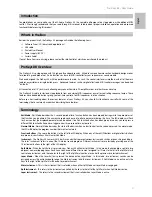
14
Program/Bank Changes Explained
The original GM or “General MIDI” specifi cation allowed for only 128 voices,
numbered from 0-127. It is possible to access any of these different voices
by sending a Program Change Message.
In order to expand on the GM set of voices, Bank Changes were devised.
Each bank contains 128 patches, which can be accessed using a Program
Change. There are 16,384 banks available, each accessible by sending a
14-bit Bank Change Message. The fi rst 7 bits of this message are sent in a
single byte known as the Bank LSB. The last 7 bits are specifi ed by another byte known as the Bank MSB. The Bank LSB is the most
commonly used This allows for 128 Bank Changes, and often there is no need to send a Bank MSB.
You will fi nd almost all MIDI devices respond to Program Change Messages, but some that do not conform to the GM set of voices
might use the Program Change Message for another purpose. Many VST or software-emulated instruments have adopted this
approach, allowing you to send a Program Change in order to change an instrument patch. The FM7 software synth by Native
Instruments is a good example of this
Bank Changes are more rarely used, although they do exist. Bank Changes are useful in many manufacturer’s built-in extensions
to the MIDI specifi cation, such as Roland’s GS or Yamaha’s XG specifi cations. Both of these require you to specify a Bank Change, in
order to access the extra voices and effects that these specifi cations provide.
Sending Program, Bank LSB and Bank MSB data is made simple using the ProKeys 88. Simply press the Program, Data LSB or Data
MSB button and enter the Program or Bank Change you wish to send.
MIDI Clock Explained
As described above, the ProKeys 88 is able to control playback of a
sequencer when the sequencer is connected to one of the MIDI out ports.
This is achieved using MIDI Clock.
This method of synchronization is part of the GM specifi cation.
The system real-time messages described below can be sent at any time.
They are assigned a high priority in the MIDI data stream to ensure timing
is maintained as accurately as possible.
Timing Clock Byte (F8h)
The Timing Clock Byte (F8h) is sent at a rate of 96 per note. So, if your ProKeys 88 has a tempo setting of 120 BPM, the timing clock
should be sent 192 times per second (2 X 96). For a tempo setting of 100 BPM, the Timing Clock Byte should be sent 160 times per
second.
Continue Byte (FBh)
When the Start Button on your ProKeys 88 is pressed, a Continue Byte (FBh) is sent, followed by a regular stream of MIDI timing
clocks (F8h). The rate at which these timing clock messages are sent is determined by tempo setting. The timing clock messages
will continue until the Stop Button is pressed.
Stop Byte (FCh)
When the Stop Button is pressed, your ProKeys 88 sends a Stop Message (FCh). If the Stop Button is pressed twice in close
succession, a SPP (Song Position Pointer) Message of 0 is sent, to reset the sequencer back to the beginning. This is achieved by
sending the SPP (F2h) followed by 0 (00h).
Troubleshooting
The ProKeys 88 has been designed to give you high performance and professional quality audio. It has been tested under a wide
range of systems and operating conditions. However, there are a virtually limitless number of operating scenarios, any of which
may affect your system’s performance. Though this section cannot cover all possible issues you may encounter, we would like to
offer you some suggestions for dealing with common problems.
We recommend that you avoid connecting too many devices to your computer at the same time. The more devices you have
connected to the computer, the greater the load on the computer’s CPU. Although it is possible in theory to chain multiple USB
devices, doing so may degrade your system’s performance.
Performance Tip #9
Edgy Bass
– Try layering the Clav and E. Bass. Add
chorus to animate the sound. This combination is great
for grooving. Try layering the A. Bass and the Clav and
reducing the A. Bass volume by one third for a cool full
keyboard comping sound.
Performance Tip #10
Spacey Split
– Select the FM E. Piano 2 program and
layer it with the Vibes. Transpose both of them down one
octave. Split the keyboard at B3 and assign the Warm Pad
to the left side of the program. Transpose the Warm Pad
up three octaves. Play pad chords with your left hand and
leads with your right. Try substituting the FM Piano 2
with other keyboard programs. Also, try substituting the
Warm Pad with the Strings program.
















